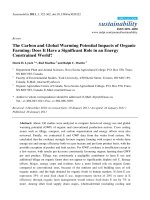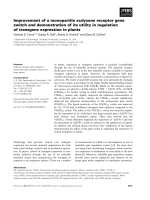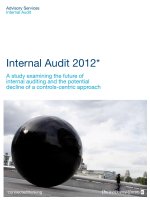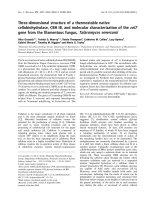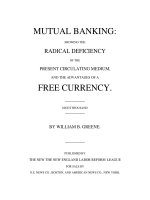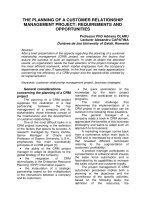ESTIMATING THE POTENTIAL IMPACTS OF A FREE TRADE AGREEMENT BETWEEN VIETNAM AND THE EUROPEAN UINON ON VIETNAM’S FISHERY EXPORTS
Bạn đang xem bản rút gọn của tài liệu. Xem và tải ngay bản đầy đủ của tài liệu tại đây (907.77 KB, 85 trang )
VIETNAM NATIONAL UNIVERSITY, HANOI
UNIVERSITY OF ECONOMICS AND BUSINESS
FACULTY OF INTERNATIONAL BUSINESS AND ECONOMICS
----------
THESIS
ESTIMATING THE POTENTIAL IMPACTS OF A FREE TRADE
AGREEMENT BETWEEN VIETNAM AND THE EUROPEAN UINON
ON VIETNAM’S FISHERY EXPORTS
Supervisor: MA. Vu Thanh Huong
Student: Nguyen Thi Huong
Honor class: QH-2011-E CLC
Hanoi, 2015
i
TABLE OF CONTENTS
TABLE OF CONTENTS .........................................................................................i
ABBREVIATIONS ............................................................................................... iii
LIST OF FIGURES ................................................................................................. v
LIST OF TABLES .................................................................................................. v
DECLARATION ..................................................................................................vii
ACKNOWLEDGEMENT ....................................................................................viii
CHAPTER 1: INTRODUCTION ............................................................................ 1
1.1
Background .............................................................................................. 1
1.2
Research objective .................................................................................... 2
1.3
Research question ..................................................................................... 3
1.4
Research scope ......................................................................................... 3
1.5
Synopsis of the thesis ............................................................................... 4
CHAPTER 2: LITERATURE REVIEW.................................................................. 5
2.1 Overview of FTA ......................................................................................... 5
2.1.1 Concept .................................................................................................... 5
2.1.2 Effects of FTA .......................................................................................... 6
2.1.2.1 Static effects ....................................................................................... 6
2.1.2.2 Dynamic effects .................................................................................. 9
2.2 The EU-Vietnam FTA (EVFTA) ................................................................ 10
2.2.1 EVFTA negotiation rounds ..................................................................... 10
2.2.2 Review of related studies ........................................................................ 13
CHAPTER 3: METHODOLOGY AND DATA .................................................... 17
3.1 Evaluating impacts of FTA methods........................................................... 17
3.1.1 Computable General Equilibrium Model (CGE) ..................................... 17
3.1.2 Partial equilibrium .................................................................................. 20
3.1.3 Gravity model ......................................................................................... 23
3.2 Methodology .............................................................................................. 25
ii
3.2.1 Trade indicators ...................................................................................... 26
3.2.2 SMART model ....................................................................................... 28
3.3 Data............................................................................................................ 28
CHAPTER 4: RESULTS AND DISCUSSION...................................................... 30
4.1 Overview of Vietnam and EU trade relation ............................................... 30
4.2 Overview of Vietnam fishery exports to the EU ......................................... 34
4.3 EU's fisheries import tariffs on Vietnam ..................................................... 40
4.4 Diagnosing the likely impacts of EVFTA on Vietnam's fishery exports to the
EU.................................................................................................................... 42
4.4.1 Revealed comparative advantage (RCA) ................................................. 43
4.4.2 Export specialization (ES) ...................................................................... 44
4.4.3 Trade intensity (TI) ................................................................................. 46
4.5 SMART simulation results ......................................................................... 47
4.5.1 Scenarios for Vietnam fishery exports .................................................... 47
4.5.2 SMART results and findings ................................................................... 49
CHAPTER 5: CONCLUSION AND IMPLICATIONS ......................................... 62
5.1 Conclusion ................................................................................................. 62
5.2 Implications................................................................................................ 68
Refferences............................................................................................................ 70
iii
ABBREVIATIONS
ADB
Asian Development Bank
AFTA
ASEAN Free Trade Agreement
APEC
Asia-Pacific Economic Cooperation
ASEAN
CGE
Association of South East Asian Nations
Computable General Equilibrium
ES
Export Specialization
EU
European Union
EVFTA
FTA
GATT
GDP
GTAP
HS
MOIT
MUTRAP
EU-Vietnam Free Trade Agreement
Free Trade Agreement
General Agreement on Tariffs and Trade
Gross Domestic Product
Global Trade Analysis Project
The Harmonized Description and Coding System
Ministry of Trade and Industry
The EU multilateral trade project with Vietnam
PTA
Preferential Trade Agreements
RCA
Revealed Comparative Advantage
RTA
Regional Trade Agreement
Agreement on the Application of Sanitary and
SPS
Phytosanitary Measures
TBT
Technical Barriers to Trade Agreement
TI
UNCTAD
Trade Intensity
United Nations Conference on Trade and
Development
USD
US Dollar
iv
Vietnam Association of Seafood Exporters and
VASEP
Producers
VJEPA
Vietnam-Japan Economic Partnership Agreement
WITS
World Integrated Trade Solution
WTO
World Trade Organization
v
LIST OF FIGURES
Figure 2.1: Trade creation of joining FTA .......................................................... 7
Figure 2.2: Trade diversion of joining FTA ........................................................ 8
Figure 4.1: The EU and Vietnam trade balance from 2001-2013 ...................... 31
Figure 4.3: Major markets of Vietnam fishery exports in 2013 (%) .................. 34
Figure 4.4: Vietnam fishery exports turnover to the EU from 2001 to 2013...... 35
Figure 4.5: Major partners in the EU of Vietnam’s fishery exports in period
2009-2013 ........................................................................................................ 40
LIST OF TABLES
Table 4.1: Top export partners of Vietnam in 2013 .......................................... 31
Table 4.2: Major Vietnam commodites exported to the EU 2007-2013 ............ 32
Table 4.3: Major commodites Vietnam imports from the EU ........................... 33
Table 4.4 : Vietnam’s fishery product codes to EU from 2001-2013 ................ 36
Table 4.5: Vietnam’s export turnover of HS03 with 4 digit ............................. 37
Table 4.6: Major fishery exporters to the EU market ........................................ 38
Table 4.7: Weighted average tariff rates applied by the EU on HS03 from some
countries .......................................................................................................... 41
Table 4.8: Weighted preferential tariff applied by the EU on the HS4 digit
Vietnam fishery products from 2011 to 2013 ................................................... 42
Tabe 4.9: RCA index of Vietnam and EU fishery exports ................................ 43
Table 4.10: ES index of Vietnam fisheries exports ........................................... 44
Table 4.11: Trade intensity index of Vietnam HS03 export to the EU .............. 46
Table 4.12: Overview of trade effects in 4 scenarios ........................................ 49
Table 4.13: Top countries gain most in scenario 1 ............................................ 51
Table 4.14: Major countries lose the market in scenario 1 ................................ 52
Table 4.15: Vietnam’s fishery products lose most ............................................ 53
Table 4.16: Top countries lose the market in the scenario 2.............................. 54
Table 4.17 : Vietnam products gain most in scenario 2..................................... 55
vi
Table 4.18: Top countries lose total trade effect in scenario 3 .......................... 57
Table 4.19: Top Vietnam’s products gain most in scenario 3............................ 57
Table 4.20: Total trade effects of some countries in scenario 4 ......................... 59
Table 4.21: Vietnam’s products gain most in scenario 4 ................................... 59
vii
DECLARATION
“I hereby declare that the work contained in this thesis is of my own and
has not been previously submitted for a degree or diploma at this or any other
higher education institution. The thesis is not previously published or written by
another person”.
1st May, 2015
viii
ACKNOWLEDGEMENT
First of all, I would like to express my sincere thanks to MA. Vu Thanh
Huong for her enthusiastic support during the period of implementing the thesis.
Thank to her supervison and guidance, I not only gain knowledges but also
sharpen skills that are helpfull in the process of my working and further learning
in the future.
I would like to give thanks to the Falculty of International Business and
Economics, University of Economics and Business and Vietnam National
University, Ha Noi for teaching and giving me a chance to complete this thesis.
Finally, I would like to express my gratitude to my family and friends
who always stand by me to support and encourage me to fulfill this thesis.
Because of research time limitation, the thesis can not avoid faults and
drawbacks. Thus, I am looking forward to receiving comments, feedbacks and
suggestions to more complete this thesis.
Respectfully hope the best wishes to my lectures.
Student
Nguyen Thi Huong
1
CHAPTER 1
INTRODUCTION
1.1 Background
Growing integration of economies and societies around the world is
evident via multilateral and bilateral efforts. However, the Doha Round of the
WTO has not progressed as expected while Free Trade Agreement (FTA) is
becoming a strong trend, especially in the Asia – Pacific region, which is
expected to have the most dynamic development all over the world in coming
decades (MUTRAP, 2014). As an active member of ASEAN, Vietnam does not
stand apart from this trend. Specifically,Vietnam has participated in eight Free
Trade Agreements including both regional and bilateral ones as well as actively
involved in negotiating severals agreements. The increasing and extensive
participation in international economic integration plays an important role for
export and import activities. Compared with USD 789.1 million in 1986, the
export turnover in 2013 increased by about 167 times (USD 132.2 billion).
Vietnam is playing an increasingly significant role in global merchandise
exports. After having trade deficit in many years, Vietnam has trade surplus in
2012 of USD 287 million; USD 9 million in 2013 and USD 1.9 billion for first
10 months of 2014 (General Department of Vietnam Customs, 2014).
Diplomatic relation between the European Union (EU) and Vietnam was
set up for the first time in October 1990 and from here, Vietnam has become one
of the main partners of the European Union in ASEAN. One of the first
milestone of bilateral relation was the signing of Cooperation Framework
Agreement (FCA) in 1995. Then, the Comprehensive Partnership Agreement
EU - Vietnam (PCA) was signed in June 2012 which expresses the
commitments of the EU to the conduction of modern, broad-based and mutually
beneficial relationship with Vietnam. The PCA broadens the scope of Vietnam-
2
EU cooperation in trade, enviroment, energy, science and technology, the fight
against corruption (European External Action Service EEAS). Especially, the
year 2015 marks the 25th anniversary of the establishment of diplomatic
relationship between the EU and Vietnam. And the most recently, the Free
Trade Agreement between Vietnam and the EU (EVFTA) is in the process of
negotiation which were started in 2012 and is expected to be completed in 2015.
EU – a huge market with 28 members is one of the most important trade
partners of Vietnam. Top 5 export commodities exported to the EU in 2013 are
footwears (USD 2,941 million), garments (USD 2,694 million), fisheries (USD
1,104 millions), computers (USD 2,200 million), telephones (USD 8,073
millions), coffee (USD 1,061 million) (Minitry of Trade and Industry, 2013).
For the fisheries sector in particular, the EU market is not only one of the most
important markets of Vietnam but also one of the largest importers of fishery
products in the world with annual volume reach to 13 million tons. According to
preliminary data of the General Department of Vietnam Customs, for the first
ten months of 2014, while Vietnam fishery exports turnover reached USD 6.55
billion the value exported to the EU market is up to USD 1.19 billion.
The assessment of the potential effects of the FTA between Vietnam and
the EU (EVFTA) on Vietnam’s fishery exports is a pressing issue in both theory
and practice. Therefore, to study and understand the possible outcomes of
EVFTA on Vietnam fishery exports, I have chosen the theme:
“ESTIMATING THE POTENTIAL IMPACTS OF A FREE TRADE
AGREEMENT BETWEEN VIETNAM AND THE EUROPEAN UNION ON
VIETNAM’S FISHERY EXPORTS”.
1.2 Research objective
The thesis aims to estimate the potential impacts of EVFTA on Vietnam's
fishery exports, identify possible opportunities as well as challenges and draw
3
out some implications for enhancing Vietnam - EU trade relations in fisheries
sector when EVFTA is concluded.
1.3 Research question
The thesis aims to answer the main research question:
"What are the potential impacts on Vietnam's fishery exports to the
EU if EVFTA concludes?"
In order to clarify the above question, following sub-questions will
be answered:
(i) “What are the trade flows of Vietnam’s fisheries to the EU?”
(ii) "What are the possibilities to bring about benefits of EVFTA
on Vietnam's fishery exports to the EU?"
(iii) “What are the potential impacts of EVFTA on exporting of
Vietnam’s fisheries to the EU?”
(iv) “What are the opportunities and challenges of EVFTA on Vietnam’s
fishery exports?
(v) What are implications for Vietnam to enhance exporting fisheries to
the EU?
1.4 Research scope
Time: thesis research the EU - Vietnam trade relations from 2001-2013
Space: Vietnam and the EU
Content:
Trade relations between Vietnam and the EU in fisheries sector.
Potential impacts of EVFTA on Vietnam's fishery exports.
Fishery products include HS03 (Fish, crustaceans, molluscs,
aquatic invertebrates), 1604 (Prepared or preserved fish, fish eggs,
caviar), 1605 (Prepared or preserved crustaceans, molluscs).
4
In the framework of this thesis, the author only assesses the
potential impacts of tariff reductions and not mention non-tariff
barriers on Vietnam's fishery exports.
1.5 Synopsis of the thesis
The thesis includes 5 chapters:
Chapter 1: Introduction
Chapter 1 provides general introduction including background, research
objectives and questions, research scope, synopsis of this thesis.
Chapter 2: Literature review
Chapter 2 includes overview of FTA, impacts on trade relations, FTA
between Vietnam and the EU, overview of some related studies as well.
Chapter 3: Methodology and data
Chapter 3 represents methodology used for analyzing impacts of FTA,
introduction of SMART model which are applied in this thesis and source of
data.
Chapter 4: Results and discussion
Chapter 4 deeply analyzes results of trade indicators and SMART
estimated results.
Chapter 5: Conclusion and some implications
Chapter 5 provides outcomes from results and suggests some implications
relating to enhance trade relation between Vietnam – the EU in fishery sector
when EVFTA will be signed.
5
CHAPTER 2
LITERATURE REVIEW
2.1 Overview of FTA
2.1.1 Concept
In 8b-Article XXIV in GATT 1947, Free Trade Agreement (FTA) “shall
be understood as an agreement between groups of two or more customs
territories in which the duties and other restrictive regulations of commerce are
eliminated on substantially all the trade between the constituent territories in
products originating in such territories”.
FTA negotiation process often lasts for a long time and even occurs in
many years. It is not limited to the traditional areas of trade such as tariffs and
quotas, but can also includes other commitments relating to the institutional
improvement, sustainable development (environment, labor), government
procurement, intellectual property protection, etc (Vietnam Trade and Industry
Review, 2014). In other word, these FTAs are called “new age FTAs”.
Particularly, in the last months of 2014, Vietnam has basically completed
negotiations with the EU, Republic of Korea and Customs Union Russia Belarus – Cazekstan which are “new age FTAs”.
Regional Trade Agreement (RTA) is onde made between two or more
contracting parties that share some common denomination known conceptually
as “region” (Oxfordbibliographies). In 7th April 2015, there are 612 notifications
of RTAs (counting goods, services and accessions separately) had been received
by the GATT/WTO and 406 ones were in forced. Of these RTAs according to
6
data from WTO, Free Trade Agreement (FTAs) and partial scope agreements
account for 90%, while customs unions account for 10%. 1
2.1.2 Effects of FTA
The establishment of a FTA will impact on society and economy of its
member countries. The two most important effects are static effects and the
dynamic effects. These effects can encourage one country to participate in the
process of trade liberalization through the benefits that it brings about.
2.1.2.1 Static effects
The static effects of FTAs generally refer to the effects on price changes
induced by preferential tariff and nontariff liberalization (ADB, 2008). Price
changes induce one-time effects, and are called “static” for that reason. The
static effects include trade creation effects and trade diversion effects.
Trade creation effects
To examine the effects of FTA we firstly consider the effects of tariff
reductions upon forming or joining an FTA. These main effects are trade
creation and trade diversion, which are shown in Figure 2.1.
1
WTO, access on 18th April, available at />
7
Figure 2.1: Trade creation of joining FTA
The above figure represents that before joining FTA, there are two
coutnries. Country A is exporter and country B is importer. Country A pay the
export price plus export tariff, P1. At price P1, country A produce quantity of
Q2, consume Q1, thus the import quantity is (Q1-Q2). Then, country A và B
join FTA. With the removal of tariff, the price of country B decrease to P2.
Consumption quantity increases to Q3 and domestic production decrease to Q4
therefor import increase to Q3-Q4.
The gain in welfare as the result of tariff reduction can be demonstrated
on this diagram. There is an increase in consumer surplus of a+b+c+d. On the
contrary, there is a reduction in the producer surplus of area a and loss in
government tariff revenues of area c. This implies that there will be always be a
net gain of b+d when trade creation occurs when a country joins a FTA.
In general, trade creation is understood that low cost FTA members’
exports replace higher cost domestic producers. Trade creation effects of an
FTA refers to a shift from consuming products in countries with a higher cost to
products lower cost from the countries member in this FTA. Due to the
reduction or elimination of tariff barriers, prices of imported goods is lower than
8
the cost of producing goods domestically in the country. This shift will result in
the reduction of domestic production by importing goods from partner countries.
Trade diversion
According to Savaltore (2004), “This effect occurs when country member
of a FTA has the imported goods at low cost from countries not members of the
FTA is replaced by the imported goods with detailed higher of FTA’ members”.
This is caused by the preferential trade treatment given to member nation.
Figure 2.2: Trade diversion of joining FTA
Afer joining FTA, the tariff removal of country A makes the product of
member country (Country B) become cheaper than a country that is not member
of FTA (Country C).
In the above diagram, before joining FTA, country A imports product at
price P1 (price with tariff of country C). At this price, country A consume Q1,
produce domestically Q2 and thus import (Q1-Q2).
When country A and country B join FTA, country A removes tariff
barrier on imports from B. The price in country B is Pb < P +tariff (this is above
9
the country C tariff free price of P3). There is an increase in consumer surplus of
area a+b+c+d
The reduction in the producer surplus of country A is area a. The country
A will loss tariff revenue of area (c+e). There will be a net loss in country A
welfare if b+d
The trade diversion means the country member of FTA loses due to
increase in imports of less effective goods, resulting in change in the structure
production. Similarly to the impacts of trade creation, although trade diversion
effects also help consumers buy cheaper goods, domestic manufacturers and
government lose partly. But the difference here is that trade diversion effects
make net social benefits be affected when the total benefits that consumers
receive not cover all the losses that local firms and the government incurs.
2.1.2.2 Dynamic effects
On the contrary of static effects, dynamic effects refer to the medium and
long term implications of regional integration and, as such, tend to be more
significant. Some of the most important dynamic effects in the context of FTAs
are economies of scale, techonology transfer and foreign direct investment
(FDI), structural policy change and reform. Dynamic effects are also more
pervasive, affecting almost all areas that relate to an economy’s competitiveness
(ADB, 2008). When become member of FTA countries have the opportunity to
expand trade, achieve efficient production and distribution from the tariff
reduction and redistribute resources more effectively. The impacts on
competition promotion is that the removal of tariffs and non-tariffs make efforts
of local companies to improve productivity and quality of product to reduce
prices and compete with foreign commodity. FTA also help to attract FDI as
investment barriers are removed. In general, dynamic effects will stimulate the
economic growth of the FTA country member.
10
2.2 The EU-Vietnam FTA (EVFTA)
2.2.1 EVFTA negotiation rounds
EU - a huge market with 28 member states - is one of the most important
trade partners of Vietnam. The EU and Vietnam launched bilateral FTA
negotiations in Brussels in June, 2012. Vietnam is the thirth country in ASEAN
after Singapore, Malaysia to negotiate FTA with the EU. Thereafter, Thailand
and the EU also started to launch negotiation process in 2013. Both Vietnam and
the EU parties are currently seeking an ambitious and comprehensive agreement
on goods, services and investment, and government procurement. Up to now,
negotiations process have undergone twelve official rounds and both Vietnam
and the EU express the detemination to complete and come to conclusion in
2015.
The first ever EVFTA negotiation round officially took place on 8th
October, 2012 and lasted until 12th October in Ha noi with the participation of
sixty experts. Tran Quoc Khanh - Vietnamese Vice Minister for Industry and
Trade is chief negotiator of Viet Nam and Mauro Petriccione - Deputy Director
General in the European Commission’s Directorate General for Trade is chief
negotiator of the EU. Both parties shared how to conduct the next negotiation
rounds in the spirit of building.2
Then, the second EVFTA negotiation round was organized on 22nd and
ended on 25th January, 2013 in Brussels, Belgium In this round, the chief
negotiator of Viet Nam along with twelve negotiation groups started to discuss
issues such as trade of goods and services, investment, intellectual property
rights, labor, enviroment (Industry and Trade newspapers, 2013).
The third negotiation round of EVFTA took place from 23rd to 26th April,
2013 in Ho Chi Minh City. Twelve groups participated in discussions issues
2.
WTO, access on 18th April, available at />
11
such as trade in goods and services, investment, customs cooperation, SPS,
TBT, sustainable development, institution and legislation.3
The fourth negotiation round of EVFTA was held from 01st July to 05th
July, 2013 in Brussels, Belgium. Three previous rounds are considered to
determine the roadmaps to unify the basic content of the agreement framework
and clarify the requirements as well as expectation to each other. Thus, this forth
round was very important in the transition from negotiation to clarify the
benefits and requirements to open each other’ market. Therefore, this round
focus on the most important issues that both two sides pay attention such as
trade in goods and services, investment, government procurement as well as
protection of intellectual property rights.4
The fifth negotiation round of EVFTA took place from the 04th to 08th
November, 2013 in Hanoi. This negotiation round marks one year that EVFTA
has been starting negotiations officially. Negotiation round took place at the
chief, vice delegation and 11 negotiating teams including trade in goods,
services, investment, customs cooperation, SPS, TBT, competition, sustainable
development. The groups continued discussing the synthesis text based on deep
discussions and more detailed approach perspective in the specific content.
Beside, they introduce a system of policies, regulations to explain the proposals
and requirements (MOIT, 2013).
The sixth negotiation round of EVFTA was started on 13th January and
ended on 17th January, 2014 in Brussels, Belgium. Both Vietnam and EU
continues promoting discussion in all sectors and has achieved positive progress
on the basis of balancing the interests of both the EU and Vietnam. The most
positve results after finishing the sixth round are that several technical groups
3
WTO Centre, />4
WTO Centre, />
12
basically agree with trade-related issues, namely, TBT, customs, pure
competition (Vietnam Trade and Industry review, 2014).
The seventh negotiation round of EVFTA was held from 17th to 26th
March, 2014 in Hanoi. After this round, there are some more technical groups
such as transparency, dispute resolution has basically agreeded while other
groups also continued to narrow the gap in content (MOIT, 2014).
The eighth negotiation round of EVFTA took place from 23rd to 27th
June, 2014 in Brussels, Belgium. The negotiating groups on trade in goods, trade
in services, investment and government procurement continued to discuss the
offer of market opening and the requirements for adjusting the offer in the
related fields (MOIT, 2014)
The ninth negotiation round of EVFTA was held from 22nd to 26th
September, 2014 in Da Nang City, Vietnam. The two sides have made positive
progress in order to find a commons in the problems still exist and toward the
conclusion of the negotiations. Negotiations focused on all the areas mentioned
in the draft FTA. Four chapters covering trade in goods, services, investment
and state-owned enterprises has progressed particularly in technical discussions.
The negotiation almost complete on the areas of trade, sustainable development
and cooperation.5
The eleventh negotiation round of EVFTA was held from 19th January to
23rd January, 2014 in Brussels, Belgium. In this round, talks focused in
particular on services, investment, government procurement, competition related
aspects, and regulatory issues. Chief negotiators also had intense discussions on
the key areas included in the FTA. Technical work was completed in three areas,
5
.WTOCentre, />
dinh-thuong-mai-tu-do-evfta
13
namely the provisions aimed at combatting fraud and the chapters on trade
remedies, trade and sustainable development (European Commission, 2015).
The twelfth negotiation round of EVFTA was held from 23rd to 27th
March, 2015 in Ha Noi. When negotiation rounds went into the final stage, it is
an important one for two sides to continue discussing the content and basically
forming the final commitment towards concluding the negotiations. Both teams
made further progress on all outstanding issues and are working towards a swiff
conclusion of the negotiations (MOIT, 2015).
Via the contents of the previous negotiation round, the EVFTA is
expected to cover the following areas:
Market access for trade in goods: elimination of tariff and non-tariff
measures; agreement on standards for key sectors; addressing SPS and TBT
issues; rules of origin
Commitments for liberalization of trade in services
Investment
Competition
Government procurement
Trade Facilitation and Customs
Regulatory environment
Sustainable development, including labour issues
State-owned enterprises and agreeing on market status
2.2.2 Review of related studies
Studies on Vietnam fisheries sector
Directorate of Fishries (2012) assessed the status of fisheries sector
development over the period 2001-2011 about the position and role in the
national economy and represents overall plan to develop the fisheries sector with
14
a vision to 2030. The evaluation methods are using secondary data, surveys to
collect information and statistics data in 63 provinces across the country.
Vu Nguyet Anh (2013) studied Vietnam fishery industry performance,
the products and market including value chain, product, major market, the
operating conditions such as regulation, policy, technology,
assistance and
major companies of Vietnam fisheries industry.
Asian Foundation and CIEM (2011) studied competitiveness of export
enterprises in three sectors: garments, fisheries and electronics in Vietnam. After
overviewing the export activities in Vietnam over the period from 2001 to 2010
and several policies affecting directly to enterprises, the report analyzes the
overall export enterprises in selected sectors with factors affecting the
competitiveness of exporters to make conclusions and recommendations.
Vietnam trade promotion agency (2007) overviewed the fishery sector
with matters of production, export situation and import situation, domestic
consumption as well. The report also gives orientation and policies to develop
the export of Vietnam fishery products.
Vietnam Ministry of Fisheries and The World Bank (2005) reviewed the
situation of the fisheries management in Vietnam and identify major areas of
interventions to reduce poverty, increase production.
It can be seen that there have been several studies relating to the fisheries
sector in Vietnam, however, the studies only focus on the overview qualitative
analysis but not assess quantitatively the impacts of EVFTA in general and
fisheries exports in particular.
The study on the impacts of the EVFTA
MUTRAP III (2011) analyzed the impacts of EVFTA by using
quantitative assessment Computational General Equilibrium and qualitative
assessment on three Vietnamese export sectors (footwear, garments and
15
furniture) and three imports sectors (automotive, electronics and machinery,
banking). CGE model concludes the positive results for all the variables
analyzed in both scenarios, namely GDP, the trade surplus, etc. This model
analysis showed that tariff reduction step by step will bring positive results in
the long term than tariff cut immediately.
Nguyen Binh Duong and Nguyen Thu Trang (2014) analyzed the trade
creation and trade diversion effects of EVFTA by using gravity model and panel
data analsis. The authors concluded that the tariff reduction in the framework of
EVFTA will have positive impacts on bilateral trade between Vietnam and the
EU. EVFTA will bring not only new opportunities as trade creation in
automotive industry but also new challenges as trade diversion in electronics and
machineries industry.
Vietnam Chamber of Commerce and Industry (2010) analyzed EVFTA
prospects and opportunities in improving the business environment such as
attracting investment of Vietnam to. However, this paper has not focused on
analyzing tariff policy for each Vietnam’s major import sector from the EU as
well as some implications about tariff policy for Vietnam in FTA negotiations.
MUTRAP III (2014) assessed the sustainable impacts of the EVFTA with
the preliminary results. Research report includes quantitative analysis based on
general equilibrium models with the assumption of liberalization commitments
under the EVFTA negotiations to estimate the impacts of the agreement on the
macroeconomy, society and environment. Three scenarios of the report are:
EVFTA may not be signed, two scenarios with signed EVFTA. The study also
assesses the impacts on several Vietnam sectors such as agriculture and
fisheries; textiles, footwears, wood, coffee, automobiles, high technology,
financial services, telecommunications services, etc. The results show that the
tariff reductions will increase Vietnam’ exports to the EU from 30% to 40%.
The sectors most likely to gain benefit from the EVFTA are textiles, footwears,
16
processed food (fisheries). In addition, the agreement is expected to increase
welfare and have positive impact on poverty reduction. A number of
recommendations are EVFTA should be signed early and Vietnam need to
allocate investment in productive sectors. However, the report has not assessed
the impacts of EVFTA integrating with other FTAs that Vietnam has signed and
negotiated such as TPP, AFTA, etc.
The studies listed above are very useful references to the author in the
process of implementing this research. However, a number of researches only
focus on analyzing the impacts of EVFTA on import sectors and other sectors of
economy such as footwear, garments or furniture while the trade relation
between the EU and Vietnam in the fisheries export sector has not been
examined and considered. Therefore, in this paper author will examine the
potential impacts of the EVFTA on Vietnam’s fishery exports to the EU.


